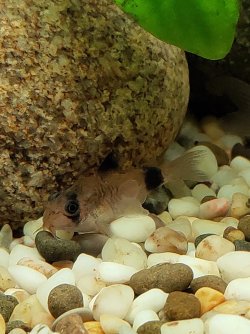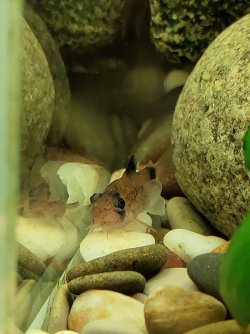You are using an out of date browser. It may not display this or other websites correctly.
You should upgrade or use an alternative browser.
You should upgrade or use an alternative browser.
Corydoras Panda need HELP
- Thread starter thief4eg
- Start date
DoubleDutch
Fish Gatherer
What is it fed?
Small bloodworm(frozen packaging) + Tetra Wafer MixWhat is it fed?
D
Deleted member 149562
Guest
Looks suspiciously like lymphocystitis...but as with everything I stand to be corrected (and probably will be corrected)
Bruce Leyland-Jones
Fish Aficionado
...Or is this an illustration of those 'fatty lumps' cories get, when fed too much protein-rich foods?Looks suspiciously like lymphocystitis...but as with everything I stand to be corrected (and probably will be corrected)
DoubleDutch
Fish Gatherer
That's what I thought Bruce but the food given isn't causing such I'd say....Or is this an illustration of those 'fatty lumps' cories get, when fed too much protein-rich foods?
The bulging eyes means a pressure build up of some sort inside the body . But what is causing it puzzles me in this case.
Bruce Leyland-Jones
Fish Aficionado
I can't help but get distracted by that substrate, which is wholly inappropriate and will accumulate all manner of decaying matter.That's what I thought Bruce but the food given isn't causing such I'd say.
The bulging eyes means a pressure build up of some sort inside the body . But what is causing it puzzles me in this case.
That said, whilst we know what is being fed, we don't yet know how much, @thief4eg .
The aquarium is young, 2 months old ... The disease is caused by nitrites (0.4mg at that moment) I think so.
Now all water parameters are ideal (ammonia and nitrite is 0%)
I thought the scales had detached, the fish will grow up and there will be new scales, but today it does not look like scales!
Now all water parameters are ideal (ammonia and nitrite is 0%)
I thought the scales had detached, the fish will grow up and there will be new scales, but today it does not look like scales!
Bruce Leyland-Jones
Fish Aficionado
There is a contradiction here.he aquarium is young, 2 months old ... The disease is caused by nitrites (0.4mg at that moment) I think so.
Now all water parameters are ideal (ammonia and nitrite is 0%)
Are you saying that your nitrites were high when the symptoms appeared?
Excess ammonia, nitrite and even nitrates can cause an excess of mucous secretions, while the fish tries to protect itself against the toxic and burning water.I thought the scales had detached, the fish will grow up and there will be new scales, but today it does not look like scales!
Just to eliminate the fatty deposit theory, could you please clarify your feeding?
The problem started 2.5 weeks ago ... When the fish got sick, there were nitrites in the water.There is a contradiction here.
For a week, the water parameters are good: nitrite / ammonia = 0, nitrates = 4, phosphates = 0.25
When I don't have time I feed Tetra (half green and half orange) for 5 Corydoras and 1 Ancistrus.Just to eliminate the fatty deposit theory, could you please clarify your feeding?
At other times I defrost bloodworms, also once a day.
DoubleDutch
Fish Gatherer
True but it is not the quantity but the quality causing such issues.I can't help but get distracted by that substrate, which is wholly inappropriate and will accumulate all manner of decaying matter.
That said, whilst we know what is being fed, we don't yet know how much, @thief4eg .
Bruce Leyland-Jones
Fish Aficionado
Understood.The problem started 2.5 weeks ago ... When the fish got sick, there were nitrites in the water.
For a week, the water parameters are good: nitrite / ammonia = 0, nitrates = 4, phosphates = 0.25
What about pH and water hardness?
Water osmosis, change once a week 25%What about pH and water hardness?
Gh=7-8
Kh=4
PH=7-7.2
Bruce Leyland-Jones
Fish Aficionado
So I think we might have 4 options;
If bacteria/fungus was involved and/or the immune system of the fish had been compromised, then aquarium salt would assist.
A dose of 1 tablespoon per 5 Imperial Gallon would be a suggested dosage, to begin with. Normally, a therapeutic dose would be 1tbsp per 3 Imp.Gal., but care has to be taken with some Corys.
IF it's the virus or any other pathogen, then your other fish, whilst looking healthy at the moment, will likely have it.
Aquarium salt is a lot safer than adding medications, without knowing exactly what it is we're adding medications for.
- A nasty case of lymphocystitis virus.
- Fatty lumps from a less-than-perfect diet.
- Excess mucous, from something in the water irritating the fish.
- Cancerous tumours.
If bacteria/fungus was involved and/or the immune system of the fish had been compromised, then aquarium salt would assist.
A dose of 1 tablespoon per 5 Imperial Gallon would be a suggested dosage, to begin with. Normally, a therapeutic dose would be 1tbsp per 3 Imp.Gal., but care has to be taken with some Corys.
IF it's the virus or any other pathogen, then your other fish, whilst looking healthy at the moment, will likely have it.
Aquarium salt is a lot safer than adding medications, without knowing exactly what it is we're adding medications for.
Similar threads
- Replies
- 14
- Views
- 707
- Replies
- 14
- Views
- 966
- Replies
- 16
- Views
- 2K
- Replies
- 23
- Views
- 2K
Most reactions
-
 456
456 -
 280
280 -
 278
278 -
 258
258 -
 234
234 -
 174
174 -
 172
172 -
 150
150 -
 149
149 -
 132
132 -
 120
120 -
 90
90 -
 80
80 -
F
64
-
 64
64


